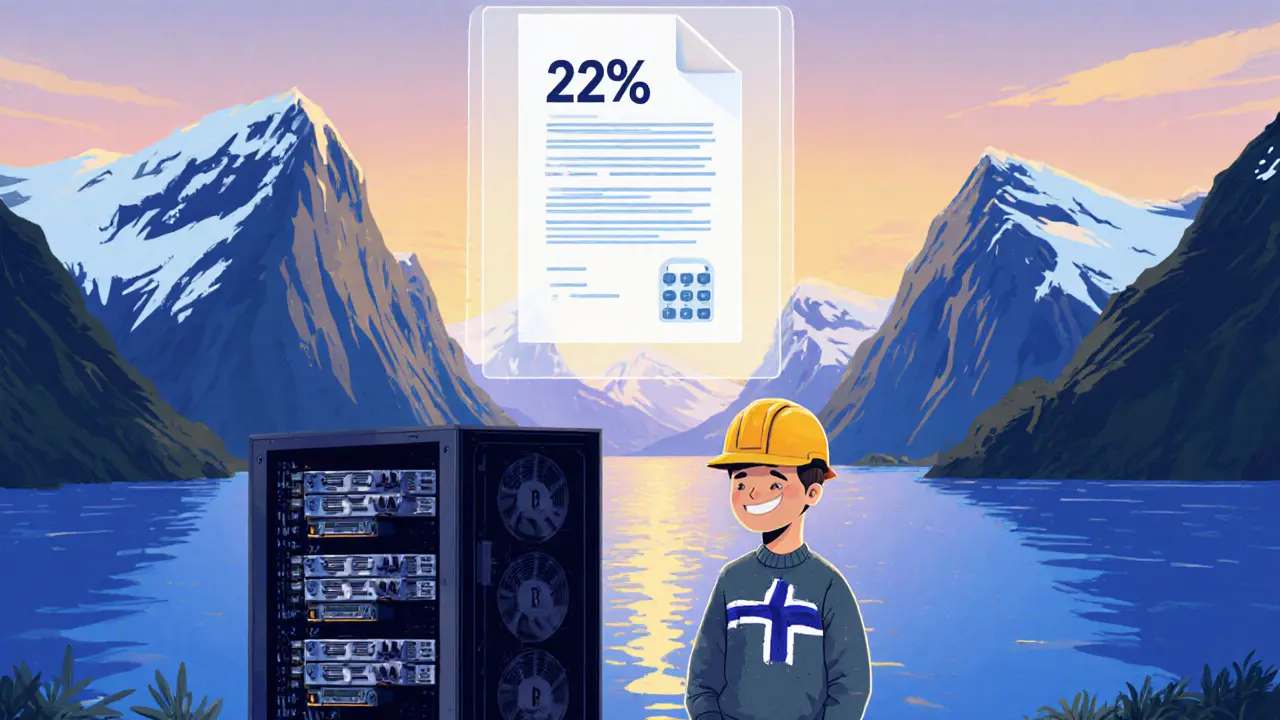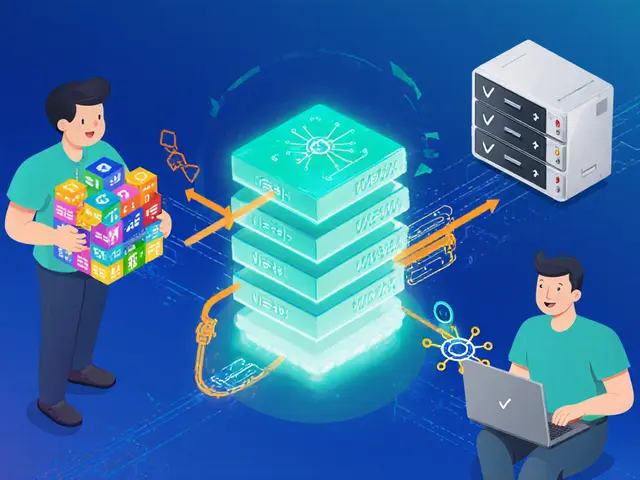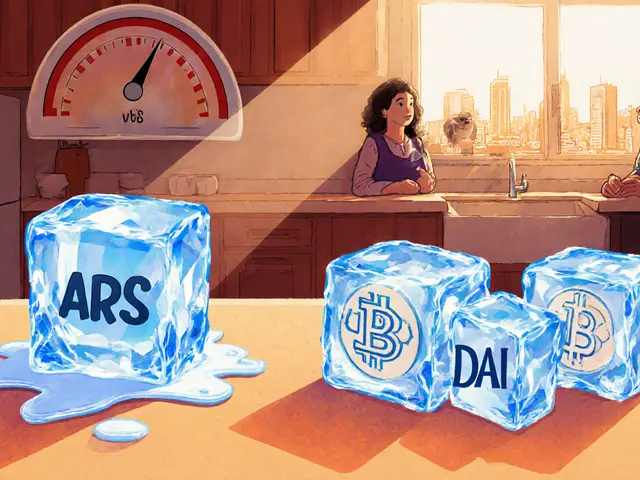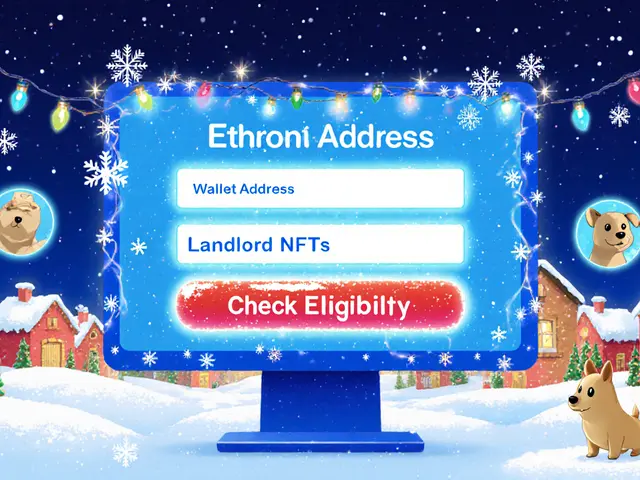Norway Crypto Mining Tax Calculator
Tax Calculation Results
Income Tax:
Equipment Depreciation:
Net Taxable Income:
Effective Tax Rate:
Crypto mining tax incentives in Norway have been a hot search phrase lately, but the reality is far less dramatic. Norway still taxes mining income at a flat 22% rate, lets miners deduct equipment and electricity, and hasn’t announced any removal of special incentives. Below you’ll find everything you need to know, from the current tax framework to what you should be doing right now.
TL;DR
- Norway does not have a dedicated crypto‑mining tax break to remove.
- Mining rewards are taxed as ordinary income at 22%.
- Equipment can be depreciated 30% per year; electricity costs are deductible.
- Report the NOK value of each coin when you receive it, and file by April 30.
- Stay ready for policy tweaks, but the baseline tax regime is stable for now.
Current Tax Landscape for Crypto Miners
In Norway, crypto mining is fully legal and falls under the standard income‑tax rules overseen by the Norwegian Tax Administration (Skatteetaten). Every coin you mine is treated as regular income, and you must declare its market value in Norwegian kroner (NOK) at the moment you receive it. The tax rate applied is a flat 22%, the same rate that applies to most other business income.
Why There Is No “Incentive Removal” to Report
Searches for “tax incentive removal” assume that Norway once offered a special break and then pulled it. The documented tax code never introduced a mining‑specific exemption. Instead, miners have always been subject to the ordinary income‑tax framework, with the usual business deductions anyone can claim. The lack of any official announcement or amendment in recent years confirms that there was never a dedicated incentive to yank.
How Mining Income Is Calculated and Reported
- When your rig solves a block, note the exact amount of cryptocurrency earned.
- Check the market price on the day of receipt (most miners use CoinGecko or similar API data).
- Convert that amount to NOK and record it as income for the tax year.
- Include the figure on your standard Skatteetaten tax return under “business income”.
- File the return by 30April of the following year; the balance sheet date is 31December.
Capital‑gain tax (another 22% rate) only kicks in when you later sell or swap those coins. Losses from other crypto activities can offset gains, and you can carry forward any net loss to future years.

Business Deductions: Equipment, Electricity, and Depreciation
Miners can deduct legitimate operating costs, which is where many find the real tax‑saving edge.
- Equipment depreciation: The tax code allows a 30% straight‑line depreciation on mining rigs, ASICs, and related hardware each year.
- Electricity costs: Norway’s low‑cost renewable power is fully deductible, provided you keep invoices and can prove the electricity was used for mining.
- Software and cooling: Licenses for mining software and expenses for cooling systems also count as deductible business expenses.
For cooperative mining pools, deductions must be split evenly among participants, which the Tax Administration verifies through shared expense logs.
Energy Context: Renewable Power and National Consumption
Crypto mining consumes about 1% of Norway’s total electricity, most of which comes from hydropower. This renewable backdrop means that miners face lower electricity prices than many other European countries, but the tax treatment of that energy remains unchanged - it’s still a deductible expense.
What Miners Should Do Right Now
- Keep detailed logs of every block reward, market price at receipt, and associated costs.
- Use accounting software that can handle multi‑currency valuation to avoid manual errors.
- Review your depreciation schedule annually; a 30% rate means you can write off most of a rig’s cost within three years.
- Stay informed about any new guidance from Skatteetaten-while no incentive removal is on the table, the agency occasionally updates reporting templates.
- Consider joining a mining association that shares best‑practice tax advice; collective lobbying has helped keep the tax regime stable.
Potential Future Scenarios (What If an Incentive Were Introduced or Removed?)
| Tax Component | Current Situation | Possible Incentive Scenario |
|---|---|---|
| Income Tax Rate | 22% flat | Reduced to 15% for mining‑specific income |
| Equipment Depreciation | 30% per year | Accelerated 50% first‑year write‑off |
| Electricity Deduction | Fully deductible | Additional 10% rebate on renewable power bills |
Even though these numbers are speculative, they illustrate why miners keep an eye on policy shifts. Any future incentive would likely be announced by the Financial Supervisory Authority (FSA) or Skatteetaten, and would be reflected in the official tax guidelines.
Bottom Line
There is no “removal” to worry about - Norway’s crypto‑mining tax regime has stayed consistent: 22% income tax, 30% equipment depreciation, and full business‑expense deductions. Your best strategy is solid record‑keeping, accurate valuation at receipt, and regular review of your deductible costs. Keep an eye on official announcements, but for now the framework is predictable and miner‑friendly.

Frequently Asked Questions
Does Norway offer any special tax break for crypto miners?
No. Mining income is taxed as ordinary business income at a flat 22% rate, with the same deductions available to any other business.
Can I deduct electricity costs from my mining income?
Yes. You can fully deduct electricity expenses provided you have proper invoices and can prove the energy was used for mining.
How do I calculate the NOK value of mined coins?
Use the market price on the exact day you receive the coins. Many miners rely on API feeds from sites like CoinGecko or CoinMarketCap to capture the spot price at receipt.
What depreciation rate applies to mining hardware?
The tax code allows a straight‑line depreciation of 30% per year on mining equipment, meaning most of the cost can be written off within three years.
When do I need to file my crypto tax return?
The balance sheet date is 31December. You must file the tax return by 30April of the following year, reporting all crypto income and assets as of year‑end.












People Comments
While many assume Norway once granted a special crypto‑mining tax break, the legislation has never distinguished mining income from other business earnings; the uniform 22 % flat rate remains applicable, and no official amendment has rescinded any such non‑existent incentive.
It’s fascinating how tax policy can mirror philosophical ideas about fairness-treating every miner’s reward as ordinary income upholds a sort of egalitarian principle, yet it also forces us to confront the hidden costs of energy consumption and market volatility.
Great job staying on top of the tax rules! Keep those records tidy and you’ll dodge headaches later 😊
Norway ain’t giving you a free ride-pay the 22 % like everyone else and stop looking for a secret handout.
From a regulatory standpoint, the absence of a mining‑specific exemption aligns with the OECD’s transfer pricing guidelines; thus, equipment depreciation at 30 % per annum and full electricity deductions constitute the primary avenues for legitimate tax mitigation.
Indeed, approaching deductions as a strategic puzzle can transform what seems like a fiscal burden into a sustainable business model-track every kilowatt‑hour, log depreciation faithfully, and your net taxable income will reflect true operational efficiency 😊
Imagine the drama of a miner juggling receipts, market spikes, and tax forms-only the most organized survive, and that’s where a solid spreadsheet becomes your hero! 😎
Our national pride shouldn’t be shackled by baseless claims of “incentive removal”; the real strength lies in Norway’s transparent tax framework that treats crypto miners like any other industrious citizen.
The narrative that Norway is secretly feeding miners is a classic example of sensationalism; the data clearly shows a consistent 22 % rate with no hidden subsidies, making any alarmist headlines purely speculative.
Let’s keep the conversation constructive-recognizing the stable tax environment can actually empower miners to plan better and focus on efficiency rather than chasing myths.
Hey folks! Just a heads‑up: keeping detailed logs of block rewards, market values, and electricity invoices not only satisfies Skatteetaten but also makes life easier when you need to prove deductions. 👍
That tax setup is pretty chill-just report what you earn, deduct your power bills, and you’re good to go.
Exactly! Think of it like painting a bright mural of compliance-every receipt and depreciation entry adds a splash of color that makes the whole picture vibrant and audit‑proof. 🎨
Honestly, the whole fuss over “incentives” is overblown; miners should just accept the 22 % rule and move on, no need for drama.
People keep shouting about a non‑existent incentive, but it’s just noise-focus on the facts, not the hype.
The Norwegian tax regime governing cryptocurrency mining has, for several fiscal periods, adhered to a uniform statutory framework that classifies mining proceeds as ordinary business income. This classification obliges miners to account for the market value of each mined unit in Norwegian kroner at the precise moment of receipt, thereby establishing a clear taxable base. The prevailing income tax rate of twenty‑two percent applies consistently across all sectors, ensuring parity between traditional enterprises and digital asset extractors. Moreover, the deduction of legitimate operational expenditures, notably electricity consumption and hardware depreciation, constitutes a recognized mechanism for reducing taxable profit. Equipment depreciation, as stipulated by the tax code, may be claimed at a straight‑line rate of thirty percent per annum, effectively enabling the amortization of capital assets within a three‑year horizon. Electricity costs, provided they are substantiated by appropriate invoicing, are fully deductible, reflecting the policy’s acknowledgment of energy as a core input for mining operations. In practice, meticulous record‑keeping of block rewards, associated market valuations, and ancillary expenses is indispensable for compliance and audit readiness. The integration of multi‑currency accounting tools is advisable to mitigate conversion errors and streamline the reporting process. While speculative discussions occasionally surface regarding prospective incentive schemes, no legislative amendment has introduced a mining‑specific tax concession to date. Consequently, fiscal predictability remains a hallmark of the current regime, affording miners the capacity to forecast net returns with reasonable accuracy. It is also noteworthy that capital gains tax, also set at twenty‑two percent, becomes relevant only upon the disposition of mined assets, thereby separating operational income from investment outcomes. The Norwegian Tax Administration (Skatteetaten) regularly publishes guidance clarifying reporting obligations, and adherence to these directives is essential to avoid penalties. In the event of future policy shifts, the authority typically communicates revisions through official channels, affording stakeholders adequate transition periods. Until such changes materialize, miners are well‑served by embracing the existing framework, optimizing deductible expenses, and maintaining comprehensive documentation. Ultimately, the stability of Norway’s tax environment, combined with its abundant renewable energy resources, positions the nation as a conducive jurisdiction for sustainable cryptocurrency mining activities.
Sounds like a lot of paperwork for a modest tax bite.
Dont worry bout the tax stuff too much, just keep ur logs and u’ll be fine.